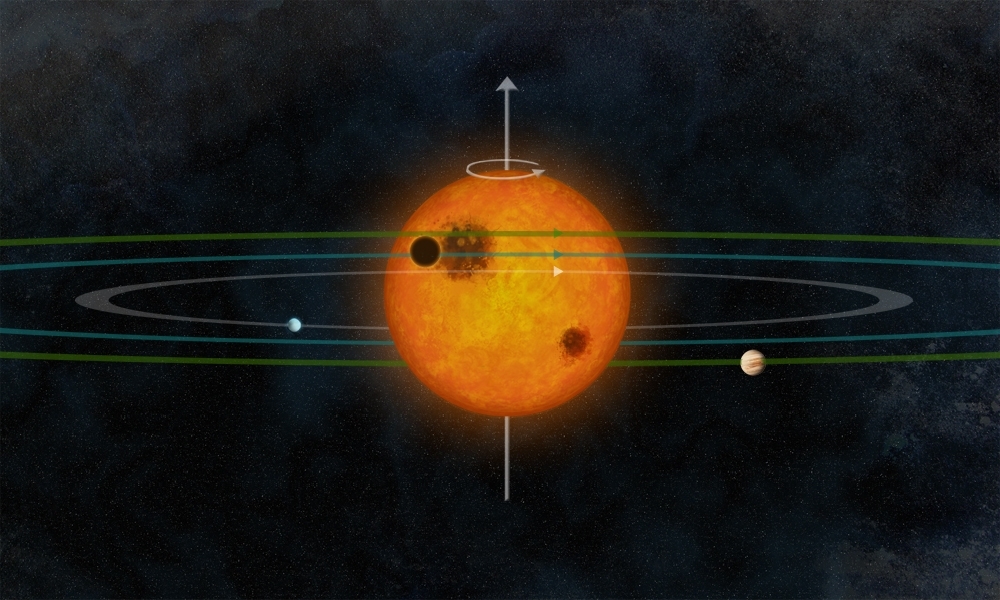
Astronomers have discovered an alien solar system whose planets are arranged much like those in our own solar system, a find that suggests most planetary systems start out looking the same, scientists say.
Researchers studying the star system Kepler-30, which is 10,000 light-years from Earth, found that its three known worlds all orbit in the same plane, lined up with the rotation of the star — just like the planets in our own solar system do. The result supports the leading theory of planet formation, which posits that planets take shape from a disk of dust and gas that spins around newborn stars.
"In agreement with the theory, we have found the star's spin to be aligned with the planets," said study co-author Dan Fabrycky, of the University of California, Santa Cruz. "So this result is profound because it is basic data testing the standard planet formation theory."
Interactions among planets can later throw such ordered arrangements out of whack, researchers added, creating the skewed orbits seen in many alien systems today. [Gallery: The Strangest Alien Planets]
Planets crossing starspots
The Kepler-30 system consists of three known extrasolar planets circling a sunlike star. All three worlds — Kepler-30b, Kepler-30c and Kepler-30d — are much larger than Earth, with two being even more massive than Jupiter.
The three planets were detected in January by NASA's Kepler space telescope, which has spotted more than 2,300 potential alien worlds since its March 2009 launch. Kepler uses the "transit method," noting the telltale brightness dips caused when a planet crosses, or transits, a star's face from the telescope's perspective.
Get the Space.com Newsletter
Breaking space news, the latest updates on rocket launches, skywatching events and more!
In the new study, the scientists studied Kepler observations of the extrasolar system even more closely.
Like our own sun, Kepler-30 has starspots, temporary blotches that appear dark because they're significantly cooler than the rest of the star's surface. The research team determined that all three planets transited the same starspot repeatedly, showing that their orbits must be coplanar and aligned closely with the star's spin.
In this sense, the Kepler-30 system looks like our cosmic neighborhood, which sports eight planets all lined up neatly along the sun's rotational equator. Both systems probably formed from a spinning disk of dust and gas, researchers said.
Not all exoplanet systems are so well-ordered. For example, many so-called "hot Jupiters" — giant planets that sit very close to their host stars — have off-kilter or even retrograde orbits. But hot Jupiters likely weren't born this way; rather, they were probably knocked askew by gravitational run-ins with other planets.
"We have excellent statistical properties of obliquities of stars that host hot Jupiters, and it seems to support the theories in which they are due to dynamical interactions among massive bodies," Fabrycky told SPACE.com via email.
The study appears online today (July 25) in the journal Nature.

More data needed
The research team stressed that the new study is a starting point of sorts. Astronomers will need more data to get a better handle on planet formation processes.
"Our work is suggestive, but we will need to observe a few more systems to show that indeed, for all coplanar systems similar to our own solar, the star's spin is aligned with the planets," said lead author Roberto Sanchis-Ojeda of MIT. "So far, we have the solar system and Kepler-30; a few more systems will be helpful to be completely sure."
Kepler should allow astronomers to study more such systems soon, Sanchis-Ojeda added.
"So far, we have identified between five and 10 new systems where we think we can apply this method, but the number is likely to grow while more data is processed," he told SPACE.com via email. "We are confident that we will be able to test our predictions in the next few years."
Follow SPACE.com senior writer Mike Wall on Twitter @michaeldwall or SPACE.com @Spacedotcom. We're also on Facebook and Google+.
Join our Space Forums to keep talking space on the latest missions, night sky and more! And if you have a news tip, correction or comment, let us know at: community@space.com.

Michael Wall is a Senior Space Writer with Space.com and joined the team in 2010. He primarily covers exoplanets, spaceflight and military space, but has been known to dabble in the space art beat. His book about the search for alien life, "Out There," was published on Nov. 13, 2018. Before becoming a science writer, Michael worked as a herpetologist and wildlife biologist. He has a Ph.D. in evolutionary biology from the University of Sydney, Australia, a bachelor's degree from the University of Arizona, and a graduate certificate in science writing from the University of California, Santa Cruz. To find out what his latest project is, you can follow Michael on Twitter.









